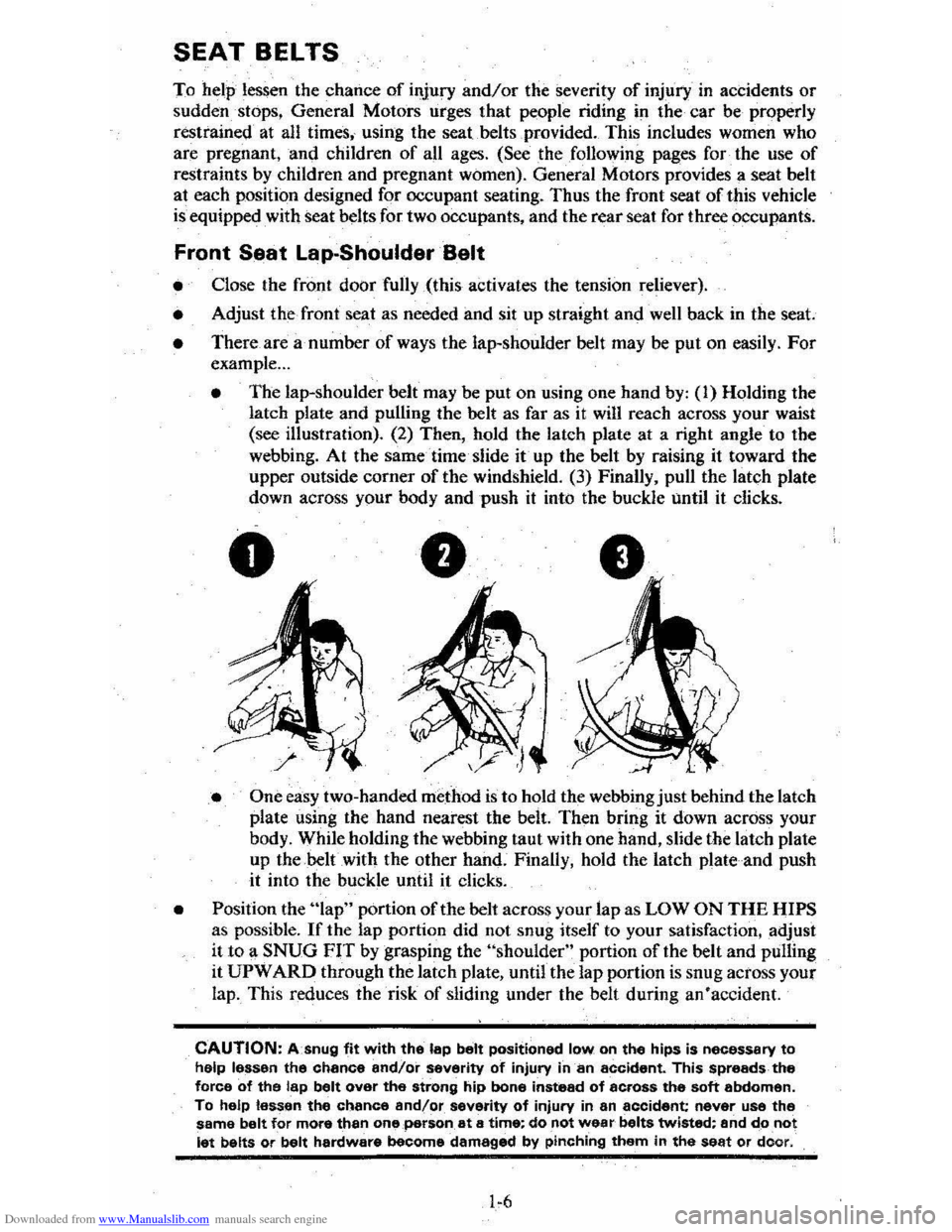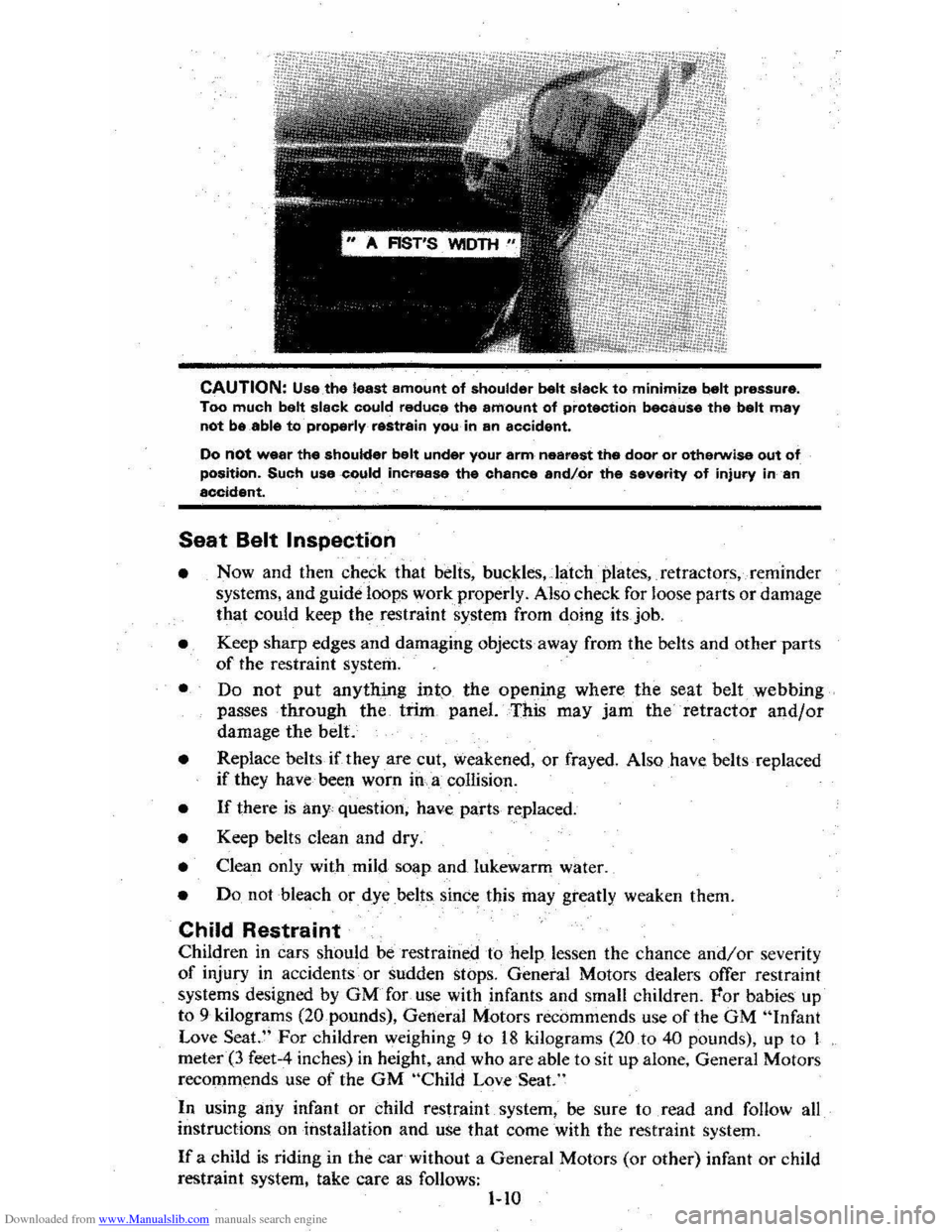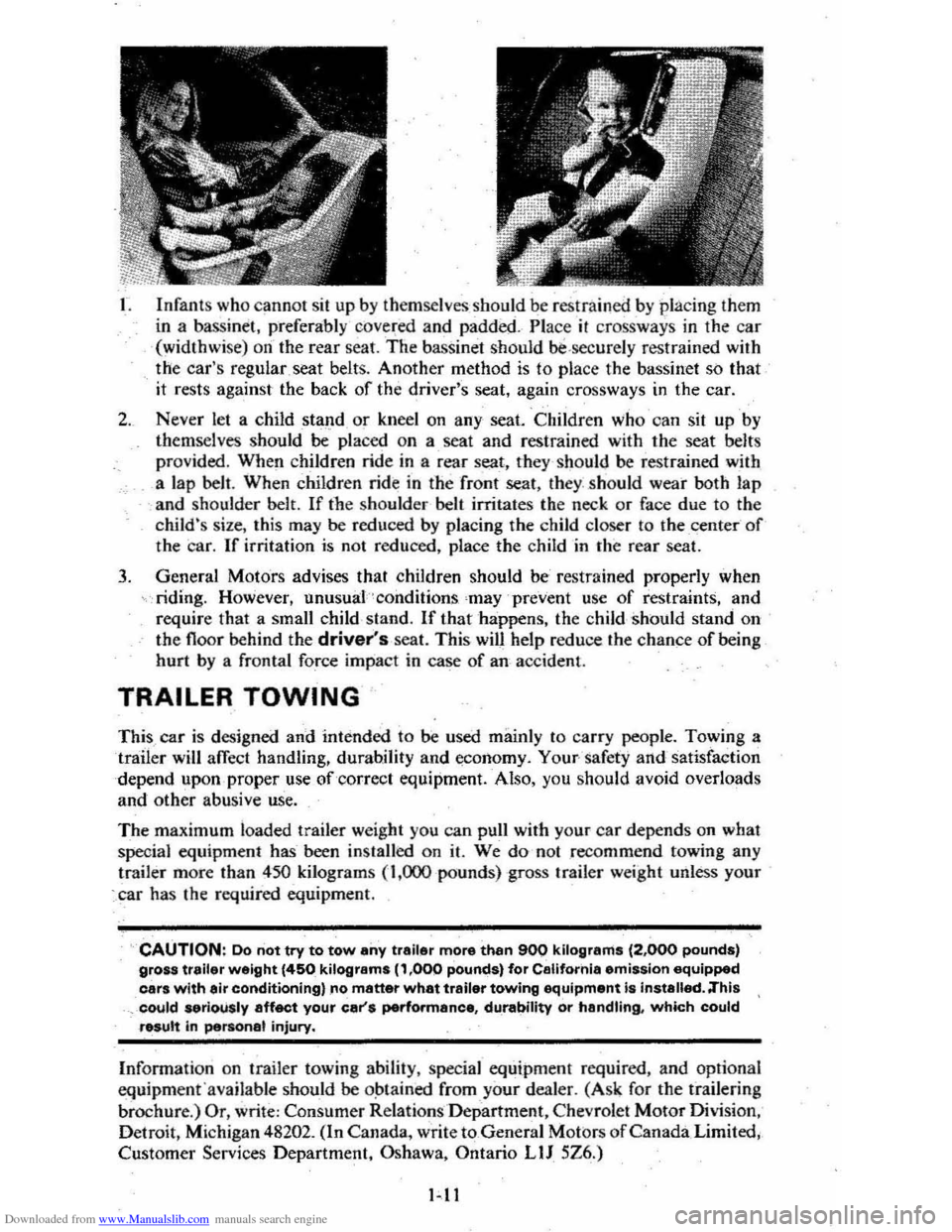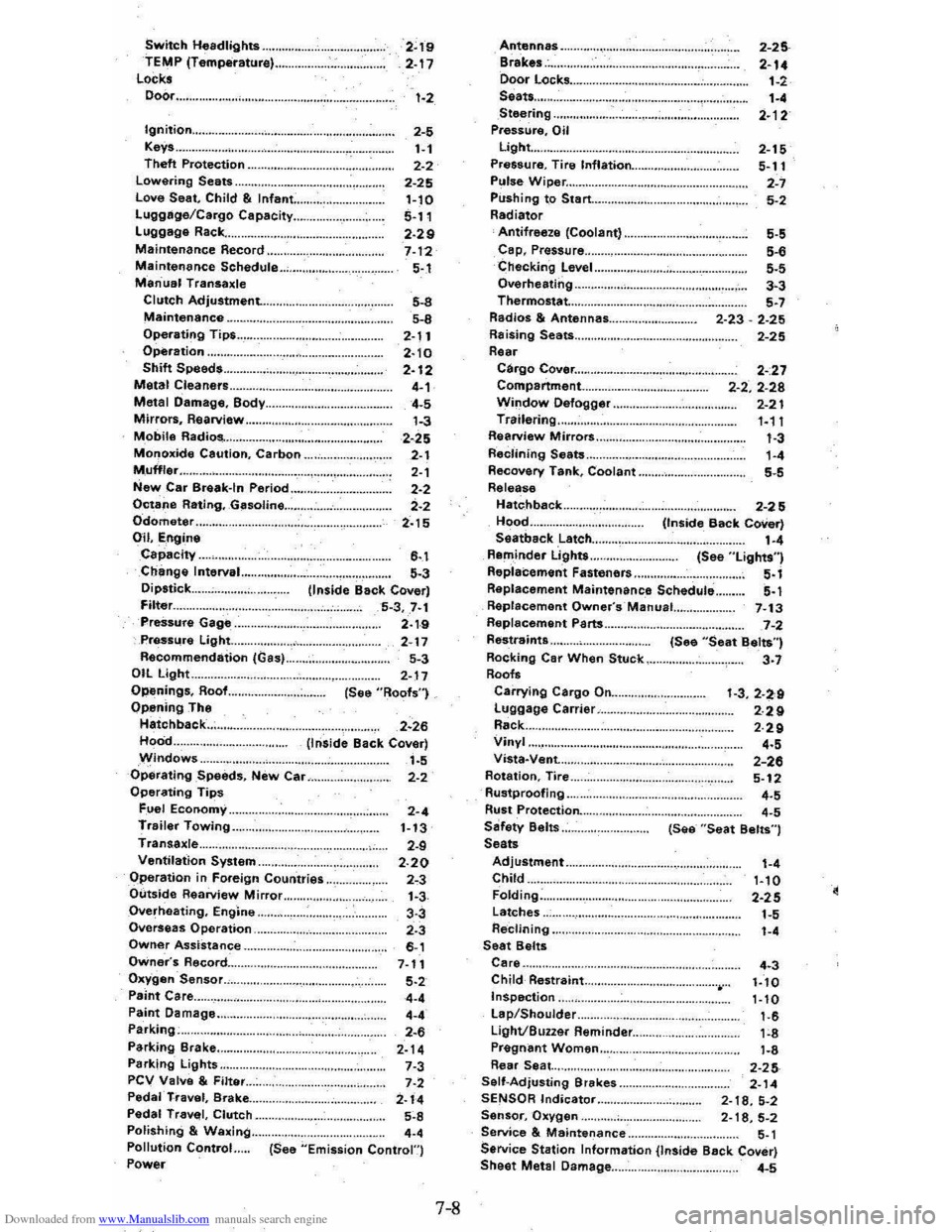1980 CHEVROLET CITATION child restraint
[x] Cancel search: child restraintPage 10 of 95

Downloaded from www.Manualslib.com manuals search engine SEAT BELTS
1'0 help lessen the chalice of injury and/or the severity of injury in accidents or
sudden,'stops, General Motors urges that people riding in the-car be properly
restrained at aU times" using the seat belts provided. This includes women who
are pregnant, and children of all ages. (See the following pages for· the use of
restraints by children and pregnant women). General Motors provides a seat belt
at each position designed for occupant seating. Thus the front seat of this vehicle
is equipped
with seat belts for two occupants, and the rear seat for three occupants.
Front S",at Lap-Shoulder Belt
• Close the front door fully (this activates the tension reliever).
• Adjust the front seat as needed and sit up straight and well back in the seat.
• There are a number of ways the lap-shoulder belt may be put on easily. For example ...
• The lap-shoulder belt may be put on using one hand by: (1) Holding the
latch plate and pulling the belt as far as it will reach across your waist
(see illustration). (2) Then, hold the latch plate
at a right angle to the
webbing.
At the sametimesJide itup the belt by raising it toward the
upper outside corner
of the windshield. (3) Finally, pull the latch plate
down across your body and push it into the buckle until it clicks.
o
• One easy two-handed tm:thod is to hold the webbing just behind the latch
plate using the hand nearest the belt. Then bring it down across your
body. While holding the webbing taut with one hand, slide the latch plate
up the
belt with the other hand. Finally, hold the latch plate and push
it into the buckle until it clicks.
• Position the "lap" portion of the belt across your lap as LOW ON THE HIPS as possible. If the lap portion did not snug itself to your satisfaction, adjust
it
to a SNUG FIT by grasping the "shoulder" portion of the belt and pulling
it UPWARD through the latch plate, until the lap portion is snug across your
lap. This reduces the
risk of sliding under the belt during an·accident.
CAUTION: A snug fit with the lap beilt positioned low on the hips is necessary to help lessen the chance and/or saverity of injury in an accident. This spreads the force of the lap belt over the strong hip bone instead of across the soft: abdomen. To help lessen the chance and/or severity of injury in an accident never use the same belt for more than one person at 8 time; do not wear belts twisted; and do not let belts or belt hardware become damaged by pinching them in the seat or door.
1-6
Page 14 of 95

Downloaded from www.Manualslib.com manuals search engine CAUTION: Use the least amount of shoulder belt slack to minimize belt pressure. Too much belt slack could reduce the amount of protection because the belt may not be able to· properly restrain you in an accident.
Do not wear the shoulder belt under your arm nearest the door or otherwise out of position. Such use could increase the chance and/or the severity of injury in an accident.
Seat Belt Inspection
• Now and then check that belts. buckles, :latch plates, retractors,reminder systems , and guide loops work properly. Also check for loose parts or damage
that could keep the restraint system from doing its job.
• Keep sharp edges and damaging objects away from the belts and other parts of the restraint system.
• Do not put anything into the opening where the seat belt webbing
passes through the trim panel. This may jam the· retractor and/or damage the belt.
• Replace belts if they are cut, weakened, or frayed. Also have belts· replaced if they have been worn ina collision.
• If there is any' question; have parts replaced.
• Keep belts dean and dry.
• Clean only with mild soap and lukewarm water.
• Do not bleach or dye _belts sinCe this may greatly weaken them.
Child Restraint
Children in cars should be restrained to help lessen the chance and/or severity of injury in accidents·· or sudden stops. General Motors dealers offer restraint
systems designed by
GMfor use with infants and small children. For babies up
to 9
kilograms (20 pounds), General Motors recommends use of the GM "Infant
Love Seat." For children weighing 9 to 18 kilograms (20 to 40 pounds), up to 1
meter(3 feet-4 inches) in height, and who are able to sit up alone, General Motors
recommends use of the GM "Child Love Seat ...
In using
any infant or child restraint system, be sure to read and follow all
instructions on installation
and uSe that come with the restraint system.
If a child is riding in the car without a General Motors (or other) infant or child
restraint system, take care as foHows: 1-10
Page 15 of 95

Downloaded from www.Manualslib.com manuals search engine L Infants who cannot sit up by themselves should be restr~ined b y placing them
in a bassinet, preferably cove~ed and padded .- Pl ace il crossways in the car
(widthwise) on-the rear seat.
The bassi net should bi!.secure ly restrained with
the car's reg ular seat belt
s. Another method is to pla ce the bassinet so that
it rests aga,inst the back of the driver's seat, again crossways in the car.
2. Never let a child sta~d or kneel on any seat. Children who can sit up by
them selves should be placed on a seat and restrained with the seat belts
provided. When children ride in a rear se:at, they should be restrained with
a lap
belt. When children ride in the fronf seat, they . ,should wear both lap
and
shou'lder belt. If the shoulder bell irritates the neck or face due to th e
child's size, this may be reduced by placing the child closer to the center of the car. If irritation is not red uced, place the child in the rear seat.
3. General Motors advises that children should be restr ained properly when
riding . However, unusual'~conditions 'may prevent use of restraints, and
requir e that a small child,
sland. If that happens, the c hild should stand on
the floo r behind the driver's seat. This will help reduce the chance of being
hurt
by a frontal force impact in case of an accident.
TRAILER TOWING
This car is designed and intended to be used mainly to car ry people. Towing a
trailer will affect handling, durability and economy_ Your'"safcty and satisfaction
depend upon,proper use
of correct equipment. Also. you should avoid overloads
and other abusive use.
The maximum loaded trailer weight you can pull with your car depends
on what special equipment has-been inst alled o n it. We do-n o t recommend towing any
trailer more than 450
kilograms (1,000 pounds) -gross trailer weight unless your
'car ha s .he required equipment.
CAUTION: Do not try to tow any trailer more than 900 kilograms (2.000 pounds)
gross trailer weight (450 kilograms (' .000 pounds) for California emission equipped
cars with air conditioning) no matter what trailer towing equipment is installed. ;This ,could .eriously affect your car'S performance. durability or handling. which could
result in personel injury.
Infonnati on on trailer towing ability, special equipment requir ed, and optional
equipm e
nfavailable should be o~lained from your dea ler . (Ask for the trailering
brochur e.)
Or, write: Consumer Relat ions Department , Chevrolet Motor Division ,
Detroit , Mi chigan
48202. (In Canada, write to General Motors of Canada Limited .
Custom
er Services Department, Oshawa. Ontario LlJ 5Z6.)
Page 90 of 95

Downloaded from www.Manualslib.com manuals search engine Switch Headlights .... TEMP (Temperature) .. Locks Door ...
2~19 2-17 1-2
Ignition ............................................. .. 2-5 1-1 2-2
2-25 Keys .. Theft Protection .. Lowering Seats .. Love Seat, Child & Infant: .. Lugglige/Cargo Capacity ... Luggage Rack ... Maintenance Record .. Maintenance Schedule .. Manual Transaxle Clutch Adjustment. .. .
1-10 5-11 2·29 7-12 5-.1
Maintenance ........................................... . 5-8
5-8
2-11
2· 10 2-12 4-1 4-5
1-3
Operating Tips .. Operation .. Shift Speeds. Metal Cleaners .. Metal Damage, Body ... Mirrors, Rearview .. Mobile Radios-. Monoxide Caution, Carbon .. . 2-25 2-1
2-1 2-2
2-2
2-15 Muffler ............................................... . New Car Break-In Period Octane Rating, Gasoline ... Odometer Oil, Engine Capacity .. Change Interval.. Dipstick ... Filter ... PreSsure Gage .. Pressure Light... Recommendation (Gas) .. OIL Light.. Openings, Roof... Opening The Hatchback ... Hood .. Windows ..
6-.1 5-3 (inside Back Cover) 5-3,7·1 2·1-9 2-17
5-3
2-17 (See "Roofs")
2·26 (Inside Back Cover) 1-5 Operating Speeds, New Car... 2-2 Operating Tips Fuel Economy.. 2-4 Trailer Towing.. 1-13 Transaxle... 2-9 Ventilation System.. 2.20 Operation in Foreign Countries.. 2"3 Outside Rearview Mirror.. 1.3 Overheating, Engine.. 3-3 Overseas Operation.. 2.3 Owner Assistance.. 6-1 Owner's Record... 7-11 Oxygen Sensor., 5.2 Paint Care.. 4-4
Paint Damage .. Parking;. Parking Brake .. Parking Lights .. PCV Valve & Filter .. Peda'·TI"avel, Brake ... Pedal Travel, Clutch .. Polishing & Waxing .. Pollution Control Power
4-' 2-. 2-14 7-3 7·2 2-14 5~8
.-. (See "Emission Contron
7-8
Antennas Brakes .. Door Locks .... Seats ... Steering Pressure, Oil Light ... Pressure. Tire Inflation ... Pulse Wiper ...
2-25
2-14
1-2 1-' 2·12
2-15
5-11
2-7
Pushing to Start ................................ .. 5-2 Radiator Antifreeze (Coolant) .. Cap, Prassure .. Checking Level .. Overheating .. Thermostat...
Radios & Antennas ... Raising Seats ... Rear Cargo Cover ...................... .. Compartment .. . Window Defogger .. Trailering .. Rearview Mirrors .. Reclining Seats .. Recovery Tank, Coolant .. Release
Hatc.hback
Hood .. Seatback Latch ... Reminder Lights ....
Replacement Fasteners
5-5 5-. 5-5 3-3 5-7
2-23 -2-25
2-25
2-:27
2-2,2-28 2-21 '·11 1-3 1-' 5-5
2-25 (Inside Back Cover)
1-' (See "Lights") 5-1
5-1 Replacement Maintenance Schedule .. Raplacement Owner's·Manual... 7-13 Replacement Parts ............. ....................... 7-2 Restraints .. Rocking Car When Stuck .. Roofs Carrying Cargo On ... Luggage Carrier .. Rack .. Vinyl .. Vista-Vent. ... Rotation, Tire .. Rustproofing .. Rust Protection ... Sefety Belts .. Seats (See
"Seat Belts") 3-7
1-3,2-2,9 2·29 2·29
'-5 2-26 5-12
'-5 '-5 (See "Seat Belts")
Adjustment.. 1-4 Child... 1-10 Folding.. 2-25 Latches..
1-5 Reclining.... . '-4 Seat Belts Care.. 4.3 Child Restraint ............................................ 1.10 Inspection.. 1-10 Lap/Shoulder.. 1-6 Light/Buzzer Reminder... 1;8 Pregn~nt Women .. Rear Seat. ... Self-Adjusting Brakes .. SENSOR Indicator ..
1-8 2-25 2-14 2-18,5-2 Sensor, Oxygen.... 2-18,5-2 Service & Maintenance.. 5-1 Service Station Information (InSide Back Cover) Sheet Metlll Damage... 4-5